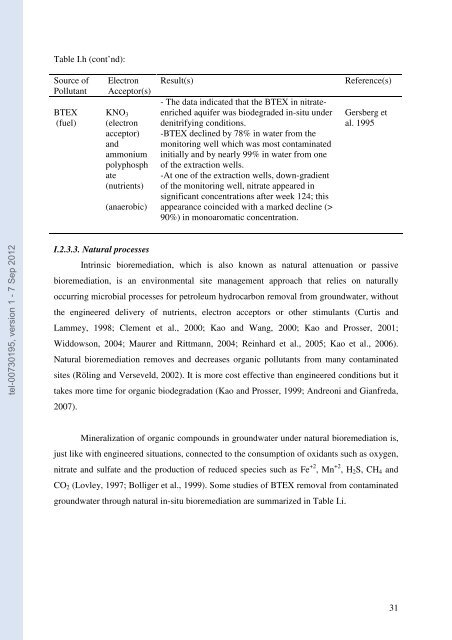Development of an effective bioremediation technology for volatile ...
Development of an effective bioremediation technology for volatile ...
Development of an effective bioremediation technology for volatile ...
You also want an ePaper? Increase the reach of your titles
YUMPU automatically turns print PDFs into web optimized ePapers that Google loves.
tel-00730195, version 1 - 7 Sep 2012<br />
Table I.h (cont’nd):<br />
Source <strong>of</strong><br />
Pollut<strong>an</strong>t<br />
BTEX<br />
(fuel)<br />
Electron<br />
Acceptor(s)<br />
KNO3<br />
(electron<br />
acceptor)<br />
<strong>an</strong>d<br />
ammonium<br />
polyphosph<br />
ate<br />
(nutrients)<br />
(<strong>an</strong>aerobic)<br />
I.2.3.3. Natural processes<br />
Result(s) Reference(s)<br />
- The data indicated that the BTEX in nitrateenriched<br />
aquifer was biodegraded in-situ under<br />
denitrifying conditions.<br />
-BTEX declined by 78% in water from the<br />
monitoring well which was most contaminated<br />
initially <strong>an</strong>d by nearly 99% in water from one<br />
<strong>of</strong> the extraction wells.<br />
-At one <strong>of</strong> the extraction wells, down-gradient<br />
<strong>of</strong> the monitoring well, nitrate appeared in<br />
signific<strong>an</strong>t concentrations after week 124; this<br />
appear<strong>an</strong>ce coincided with a marked decline (><br />
90%) in monoaromatic concentration.<br />
Gersberg et<br />
al. 1995<br />
Intrinsic <strong>bioremediation</strong>, which is also known as natural attenuation or passive<br />
<strong>bioremediation</strong>, is <strong>an</strong> environmental site m<strong>an</strong>agement approach that relies on naturally<br />
occurring microbial processes <strong>for</strong> petroleum hydrocarbon removal from groundwater, without<br />
the engineered delivery <strong>of</strong> nutrients, electron acceptors or other stimul<strong>an</strong>ts (Curtis <strong>an</strong>d<br />
Lammey, 1998; Clement et al., 2000; Kao <strong>an</strong>d W<strong>an</strong>g, 2000; Kao <strong>an</strong>d Prosser, 2001;<br />
Widdowson, 2004; Maurer <strong>an</strong>d Rittm<strong>an</strong>n, 2004; Reinhard et al., 2005; Kao et al., 2006).<br />
Natural <strong>bioremediation</strong> removes <strong>an</strong>d decreases org<strong>an</strong>ic pollut<strong>an</strong>ts from m<strong>an</strong>y contaminated<br />
sites (Röling <strong>an</strong>d Verseveld, 2002). It is more cost <strong>effective</strong> th<strong>an</strong> engineered conditions but it<br />
takes more time <strong>for</strong> org<strong>an</strong>ic biodegradation (Kao <strong>an</strong>d Prosser, 1999; Andreoni <strong>an</strong>d Gi<strong>an</strong>freda,<br />
2007).<br />
Mineralization <strong>of</strong> org<strong>an</strong>ic compounds in groundwater under natural <strong>bioremediation</strong> is,<br />
just like with engineered situations, connected to the consumption <strong>of</strong> oxid<strong>an</strong>ts such as oxygen,<br />
nitrate <strong>an</strong>d sulfate <strong>an</strong>d the production <strong>of</strong> reduced species such as Fe +2 , Mn +2 , H2S, CH4 <strong>an</strong>d<br />
CO2 (Lovley, 1997; Bolliger et al., 1999). Some studies <strong>of</strong> BTEX removal from contaminated<br />
groundwater through natural in-situ <strong>bioremediation</strong> are summarized in Table I.i.<br />
31

















